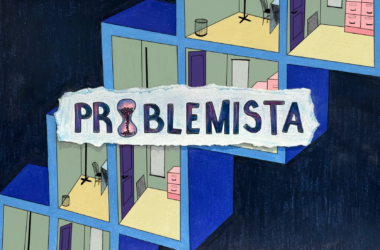For some, electronic music is a seasonal interest that begins and ends with Montreal’s annual Piknic Électronik festival. It takes a keen ear and an open mind to truly appreciate the genre in all of its noisy magnificence. For those indoctrinated into the world of ambient, dance and experimental music, however, the beauty lies in the strangeness and the unfamiliarity. Here are some of our favourite electronic releases from the month of September.
‘Konoyo’—Tim Hecker
Kevin Reynolds
Contributor
For the past decade, Tim Hecker has been the closest thing the world of contemporary ambient music has to an idol. With his ninth album Konoyo, released on Sept. 28, the Montreal-based electronic musician continues to deliver the tightly-crafted sound that has previously garnered him such acclaim.
Hecker’s past albums have varied in style, from the modulated choral music of Love Streams, to the multi-textured, cacophonous percussion collages he showcased on Virgins. Konoyo, on the other hand, delves into long and droning sounds with little in the way of rhythm to anchor the albums tracks as they bleed into each other. Konoyo sees Hecker continuing his experimental trajectory. Past listeners will recognize similarities between his latest effort and albums like Harmony in Ultraviolet. Both feature long, droning tracks that move deeper and deeper within themselves rather than towards any sort of climax. Still, Konoyo has its own sound entirely.
For Konoyo, Hecker collaborated with Tokyo Gakuso, a group of musicians who play gagaku—music from the traditional courts of Japan. Often hidden behind layers of reverberating noise, the instruments, mostly flutes and mouth organs, occasionally peek through. Usually, though, it’s Hecker’s manipulated sound, and layers of hazy noise that come forth to the front of the record.
While certainly enjoyable, Konoyo is not an easy listen. With no vocals and minimal sonic variation, Hecker’s sounds are often jarring, if not unnerving.
Despite the lack of conventional structure, Konoyo remains evocative. The album’s second track, “In Death Valley,” for example, opens with lush instrumentation before sinking back into the atonal noise that is characteristic of Hecker’s music. All of this is to say that, what Konoyo lacks in the terms of rhythm and melody, it makes up for with captivatingly barren soundscapes and dark emotion.
Konoyo might not be an album you want to play in front of strangers or music to listen to on a sunny day. It might, however, be the perfect album to put on while walking in the dark of night. For fans of Hecker, or anyone who just wants to put something on to make themselves uncomfortable, Konoyo is a must-listen.
‘Collapse’—Aphex Twin
Alyssa Nazmi
Contributor
In the latest release of his post-hiatus career, prolific electronic artist Richard D. James, under the moniker Aphex Twin, taps into an even quirkier sound while revisiting the intricate electro characteristic of his early discography. Since his first release in 1991, the Cornish recluse has become synonymous with the ambient techno and electro that characterized the ‘90s electronic scene, establishing him as one of the most honored and influential figures in his industry The iconic disfigured Aphex Twin logo cropped up in London, New York, Turin, Los Angeles, and Tokyo a couple of months ago, discreetly announcing the release of Collapse. It wasn’t long before an internet frenzy erupted, culminating in the EP’s release on Sept. 14.
With an abundance of releases under multiple monikers, James’ work covers a vast stylistic spectrum, ranging from organic and emotive cuts like “Avril 14th,” to purely-manic, disturbing noise (James once performed a live set in which he played the sound of a blender for over five minutes). As its title suggests, Collapse is an intricately-designed apocalyptic soundscape, departing from the languid electro of his previous release, Cheetah (2016).
“T69 Collapse” throttles listeners into the bustling future with its glitchy clattering of drums, only to abruptly dissolve into cacophony. James’ ability to humanize heady electronic composition shines through on “1st 44”: He deconstructs a typical footwork jam, splicing the familiar sounds of claps, snares, and bass into echoing samples resulting in an uncanny, abstracted cut that retains a palpable eeriness.
Collapse reshapes elements within James’ stylistic comfort zone, offering a glimpse into the musician’s reflection on his own creative processes. The EP’s rich sound parallels the work of contemporary producer, Jlin, whom James has collaborated with before. It is refreshing to see an artist as acclaimed as James let inspiration flow from his surroundings. Although Collapse does not stand out as one of the best releases in James’ accomplished career, it is a solid addition to his work.
‘Safe in the Hands of Love’—Yves Tumor
Noah Simon
Contributor
Every so often, an album comes along that digs into your consciousness and festers there. After one listen, it is impossible not to immediately listen again. And again, and again, and again. Yves Tumor’s Safe in the Hands of Love (SITHOL), with its genre-bending, mind- altering collage of sound, is one such album.
Tumor released SITHOL on Sept. 5 to near-unanimous praise. Though labelled experimental by critics and fans alike, SITHOL also dabbles in mainstream genres of alternative rock, punk, R&B, house, and Intelligent Dance Music. It is rife with catchy melodies, earworm beats, and cathartic breakdowns.
None of this is to say that the album doesn’t include strange and challenging moments, particularly as it descends into madness during its second half and becomes more abstract, like in “Hope In Suffering.” But, in many ways, these songs resemble pop with their adherence to familiar ideas—“Noid” is straight-forward social commentary with a catchy and memorable hook. Tumor takes existing, mainstream elements and bends them as much as as he can, invoking the spirit of experimental tradition.
Some songs end abruptly, sometimes mid-verse, such as the opener “Faith in Nothing Except Salvation,” while others unfold unconventionally with odd pacing. “Licking an Orchid” and “Recognizing the Enemy” feature guitar loops that sound like a broken record that never gets fixed, invoking a circular chaos.
It feels fitting, then, that the final track ends as a seeming continuation of the opener, while still ending mid-thought, further complicating when exactly this broken album starts and finishes. All you can do is start it all over again and try to put it together.









